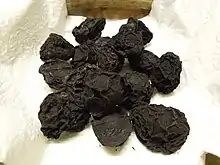Smoked plum
Smoked plum is the smoked fruit of Asian plums, used in East Asian cuisine and medicine. It is called wūméi (烏梅) in Mandarin, omae (오매; 烏梅) in Korean, and ubai (烏梅; うばい) in Japanese.


Overview
Smoked plums, matte black to dark brown, with a rugged surface, have a unique flavor with a sour taste.[1] The fruit is spherical or oblate, around 2–3 centimetres (0.79–1.18 in) long and 1.5–2 centimetres (0.59–0.79 in) in diameter.[2] The surface is wrinkled, with the round stem-end underside.[2] The fruit kernel is hard, olate, yellowish brown, 1–1.4 centimetres (0.39–0.55 in) long, 1 centimetre (0.39 in) wide, and 0.5 centimetres (0.20 in) thick, with a dotted surface.[2] The seed is flat obloid and light yellow.[2]
Production
Unripe plums are picked in early summer, smoked, and dried at 40 °C (104 °F).[3]
Use
Cuisine
In China, smoked plums are used to make suānméitāng, a sour plum drink.
In Korea, smoked plums are used to make traditional teas and drinks such as omae-cha (smoked plum tea) and jeho-tang (medicinal summer drink).
Medicine
Latin (pharmaceutical) name for smoked plums is Mume Fructus.[2]
In Traditional Korean medicine, smoked plums are considered conductant for the liver channel, spleen channel, lung channel, and large intestine channel.[3] It is used to treat ascariasis, vomiting, cough, and diarrhea.[3] It is reported to relieve phlegm, inhibit intestinal motility, and fight bacteria in pharmacologic experiments.[3]
See also
References
- "omae" 오매. Doopedia (in Korean). Doosan Corporation. Retrieved 16 June 2017.
- Kim, Chang-Min; Lee, Young Jong; Kim, In Rak; Sin, Jeon-Hwi; Kim, Yang Il (2015). "omae" 오매. Hanyakjae gambyeol dogam 한약재감별도감 [Coloured Illustrations for Discrimination of Herbal Medicine] (in Korean). Academy Seojeok. p. 304. ISBN 9788976164865. Retrieved 16 June 2017 – via Naver.
- "omae" 오매. Hanuihak dae sajeon 한의학대사전 [The Korean medical dictionary] (in Korean). Seoul: Jungdam Publishing. 1998. ISBN 9788980850297. Retrieved 16 June 2017 – via Naver.